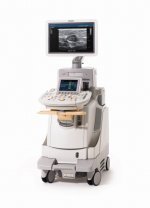by
Brendon Nafziger, DOTmed News Associate Editor | December 07, 2009

Philips' latest upgrade
to its ultrasound
platform, the iU22,
will feature elastography
(in the U.S., pending
FDA clearance)
Although the first investigations on it began in the 1980s, elastography appears to have finally come into its own as a viable method, at least that's the impression given at the Radiological Society of North America's annual meeting last week.
One of the complaints against conventional ultrasound is that, while non-invasive, radiation-free and reasonably sensitive, it is often not very specific, and can require a highly trained expert to get the most out of it.
Enter elastography, an ultrasound technique related to one of the oldest modalities: a hands-on clinical examination. Since ancient Egypt, supposedly, physicians have palpated body parts to determine tissue stiffness. What they didn't know, but what we suspect now, is that malignant lesions are stiffer, or less elastic, than benign ones. Elastography allows doctors to use ultrasound waves to determine the stiffness of a lesion compared with surrounding tissue, which could be useful in telling apart benign fibrous growths from deadly malignancies in the breast or other areas.



Ad Statistics
Times Displayed: 316
Times Visited: 2 Keep biomedical devices ready to go, so care teams can be ready to care for patients. GE HealthCare’s ReadySee™ helps overcome frustrations due to lack of network and device visibility, manual troubleshooting, and downtime.
Best for breast?
At RSNA, Dr. Stamatia Destounis, a radiologist from Rochester, NY, presented evidence from an ongoing study that elastography was about 98 percent sensitive for malignant lesions in the breast and 78 percent specific -- far higher than conventional ultrasound. (See DM 10903).
Dr. Destounis calls elastography an "old-new" technique, because, though research began more than 20 years ago, it's only now becoming truly commercially available. She says it appears to offer promise in breast cancer detection. And, it seems, vendors agree.
On the floor, Philips was touting its iU22 Ultrasound system, the latest version of their flagship ultrasound cart, which now features elastography -- in Europe at least, as it's pending FDA clearance, which is expected sometime early next year.
Philips had on hand a plastic model breast for testing, and this reporter, a non-medically-trained correspondent, was able to move the wand around to detect a suspicious "lump," whose hardness rating came up on screen. In Europe, the iU22 can ship with statistical software that actually assigns a true numerical rating to the tissue's toughness. But because the software isn't FDA-cleared, and won't be, presumably, until clinical trials are wrapped up, U.S. doctors may have to settle for a scale that color-codes lesions along a qualitative spectrum from "hard" to "soft." Philips says the underlying algorithms are just about the same. Note that software clearance may come well after the machine itself is cleared for U.S. sale.

